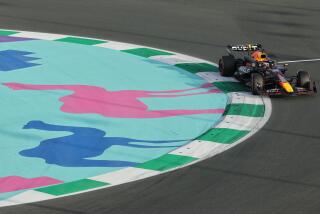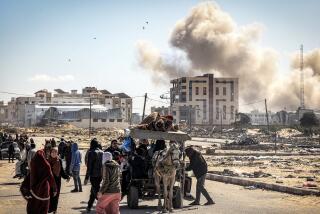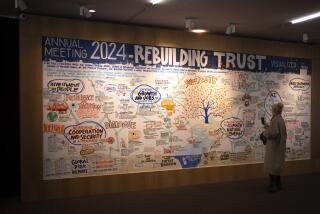Will Baghdad Be the Tokyo of the Mideast?
- Share via
BAGHDAD, Iraq (February, 2006) — Jammed with automobiles and ambition, the streets here radiate a parvenu affluence. Even the cries of the muezzin from their graphite composite minarets sound prosperous.
The Arabs call it mu’jizat al-Iqtisad al-Islami --the miracle of Islamic economics. Westerners call it an economic miracle that rivals postwar Germany’s Wirtschaftwunder and Japan’s rise to industrial superstardom.
An overstatement? Perhaps. But there’s no question that the astonishing growth of the Islamic Economic Alliance--which now stretches from Turkey through Oman--now eclipses the wealthy dragons of the Pacific Rim. Certainly, none of the “experts” predicted how quickly the once-fragmented Arab nations would coalesce into a regional economic cooperative in the turbulent aftermath of the 1991 Gulf War.
“Throughout history, people have been surprised by which nations went ahead and which ones were left behind,” economist Mancur Olson noted 15 years ago. His “The Rise and Decline of Nations” is still regarded as an economic development classic. “Voltaire once said: ‘The Germans will always be poor.’ Ultimately, it’s the institutions that countries have that determine how well they do. There does appear to be some social learning between nations. Stable and efficient institutions are key. People do learn from examples--including bad examples.”
The Arabs have obviously learned. The gradual transformation of Kuwait and Saudi Arabia into constitutional monarchies was critical. The U.S.-inspired plan for the Arabian Bank for Reconstruction and Development to reinvest petrodollars within the region proved crucial to infrastructure investment. To this day, the Saudis and the Kuwaitis privately joke about the “Ministry of Bechtel.”
But, beyond doubt, the turning point in the region’s economic destiny occurred with the 1993 signing with Japan of the Abbasid Agreements. Named for the ancient caliphate that represented the flowering of Islamic culture--particularly in science and technology--a millennium ago, the agreement marked the first comprehensive effort to create a regional climate for growth. While craving Western technology, the Islamic societies still distrusted Western cultural influences. Japan--then as now, Saudi Arabia’s largest customer--opportunistically exploited the opening.
In exchange for a stable supply of cheap petroleum, Japan agreed not only to transfer technology to the Arab states but also to invest in manufacturing facilities in the poorer Arab nations. The Japanese reportedly clinched the deal when minister-without-portfolio Shintaro Ishihara told an assembly of sheiks and mullahs: “Look at what we now own in America; the best way to conquer Israel is to surround it with wealth and buy it. Patience plus profits equal power.”
A conclave of the region’s leading mullahs and Islamic scholars subsequently called for a “renaissance and rebirth of Islam’s historic leadership in divining the ways of Allah to enrich the lives of his followers.” In essence, science and technological development were declared completely compatible with the teachings of Islam. “There was a tremendous willingness to experiment so long as it can be clothed in Islamic garb,” asserted American development economist Timur Kuran, who specializes in Islamic economies.
The groundbreaking for the first Toyota plant here in Iraq occurred three years later as part of this nation’s massive reconstruction. In Yemen today, workers at the new Mitsubishi light truck assembly plant are so excited about its prospects that they don’t start chewing their khat--the Yemeni national narcotic--until after the 5:30 whistle instead of lunchtime. The Europeans and Chinese are now calling for Arab automobile import quotas.
“We have almost come as far as Japan did in almost half the time,” boasts Tarik ibn Mustafa, a Stanford University MBA who is general manager of Sony’s computer memory chip facility in Basra.
Since the Gulf War, the region’s gross national product has nearly quadrupled--a rate that easily exceeds Taiwan’s unprecedented growth during the 1960s. Part of that is because of the careful petroleum pricing policies. The Gulf oil states have now sufficiently diversified into petrochemicals and specialty chemicals--they own significant minority stakes in Germany’s Hoechst, America’s Dow Chemical and Great Britain’s ICI--that they want to smooth any chance of price spikes. What’s more, regional industrialization has drastically reduced the need to redistribute the Gulf oil states’ cash flows.
In fact, the Islamic Economic Alliance has become so integrated into the rest of the world’s economy through trade and equity investment that providing a stable supply of oil at a moderate price has proven the wisest and wealthiest of strategies. Oil hasn’t been described as a “weapon” in more than a decade. Indeed, it is now described as “the great lubricant” that makes the wheels of global commerce turn smoothly.
Make no mistake: The Middle East is still different. Unlike Western and Eastern capitalism, the invisible hand in the market is Allah’s, not Adam Smith’s. The point of the market is not to maximize wealth but to live up to the tenets of the Koran. Where the Koran forbids the charging of interest, Islamic scholars, bankers and entrepreneurs are quite comfortable calling it “profit sharing.” Islamic technologies tend to be more environmentally attuned than some of their Asian and Occidental counterparts. It turns out that, just as the history of the West reveals, theological reinterpretations can inspire new economic opportunities.
There will always be tensions between the fundamentalists and the secularists--but the tensions here seem more bearable with an automobile, a VCR and a desert blooming with produce. The wealthiest sheiks and princes have always enjoyed petrolifestyles to be envied. Today, the middle-class lifestyle in an Egypt or Transjordan surpasses that of their Israeli neighbors. Apparently, living well is the best revenge.
At the turn of the last century, Germans visiting England would write letters despairing about how hard-working the British were compared to the typical Rhinelander. As late as the 1950s, Westerners presumed that the Asian countries would remain hopelessly agrarian.
The lesson is clear: Given the right blend of political freedom, cultural orientation and market-sensitive government institutions, economic growth can accelerate anywhere in the world. The Islamic Economic Alliance was an economic miracle waiting to happen.
More to Read
Sign up for Essential California
The most important California stories and recommendations in your inbox every morning.
You may occasionally receive promotional content from the Los Angeles Times.










